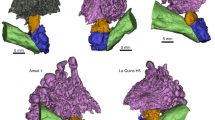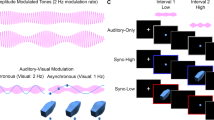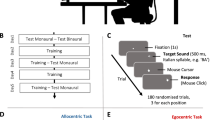Abstract
Although ears capable of detecting airborne sound have arisen repeatedly and independently in different species, most animals that are capable of hearing have a pair of ears. We review the advantages that arise from having two ears and discuss recent research on the similarities and differences in the binaural processing strategies adopted by birds and mammals. We also ask how these different adaptations for binaural and spatial hearing might inform and inspire the development of techniques for future auditory prosthetic devices.
This is a preview of subscription content, access via your institution
Access options
Subscribe to this journal
Receive 12 print issues and online access
$209.00 per year
only $17.42 per issue
Buy this article
- Purchase on Springer Link
- Instant access to full article PDF
Prices may be subject to local taxes which are calculated during checkout



Similar content being viewed by others
References
King, A.J., Schnupp, J.W.H. & Doubell, T.P. The shape of ears to come: dynamic coding of auditory space. Trends Cogn. Sci. 5, 261–270 (2001).
Wightman, F.L. & Kistler, D.J. Monaural sound localization revisited. J. Acoust. Soc. Am. 101, 1050–1063 (1997).
Carlile, S., Martin, R. & McAnally, K. Spectral information in sound localization. Int. Rev. Neurobiol. 70, 399–434 (2005).
Stern, R.M. & Trahiotis, C. Models of binaural interaction. in Hearing (ed. Moore, B.C.J.) 347–380 (Academic, San Diego, 1995).
van Hoesel, R.J. Exploring the benefits of bilateral cochlear implants. Audiol. Neurootol. 9, 234–246 (2004).
Long, C.J., Carlyon, R.P., Litovsky, R.Y. & Downs, D.H. Binaural unmasking with bilateral cochlear implants. J. Assoc. Res. Otolaryngol. 7, 352–360 (2006).
Grantham, D.W. & Wightman, F.L. Detectability of a pulsed tone in the presence of a masker with time-varying interaural correlation. J. Acoust. Soc. Am. 65, 1509–1517 (1979).
Christensen-Dalsgaard, J. & Carr, C.E. Evolution of a sensory novelty: tympanic ears and the associated neural processing. Brain Res. Bull. 75, 365–370 (2008).
Clack, J.A. The evolution of tetrapod ears and the fossil record. Brain Behav. Evol. 50, 198–212 (1997).
Grothe, B., Carr, C.E., Casseday, J.H., Fritzsch, B. & Köppl, C. The evolution of central pathways and their neural processing patterns. in Evolution of the Vertebrate Auditory System (ed. Manley, G.A., Popper, A.N. & Fay, R.R.) (Springer, New York, 2004).
Jeffress, L.A. A place theory of sound localization. J. Comp. Physiol. Psychol. 41, 35–39 (1948).
Carr, C.E. & Konishi, M. Axonal delay lines for time measurement in the owl's brainstem. Proc. Natl. Acad. Sci. USA 85, 8311–8315 (1988).
Parks, T.N. & Rubel, E.W. Organization and development of brain stem auditory nuclei of the chicken: organization of projections from n. magnocellularis to n. laminaris. J. Comp. Neurol. 164, 435–448 (1975).
Beckius, G.E., Batra, R. & Oliver, D.L. Axons from anteroventral cochlear nucleus that terminate in medial superior olive of cat: observations related to delay lines. J. Neurosci. 19, 3146–3161 (1999).
Smith, P.H., Joris, P.X. & Yin, T.C. Projections of physiologically characterized spherical bushy cell axons from the cochlear nucleus of the cat: evidence for delay lines to the medial superior olive. J. Comp. Neurol. 331, 245–260 (1993).
Shamma, S.A., Shen, N.M. & Gopalaswamy, P. Stereausis: binaural processing without neural delays. J. Acoust. Soc. Am. 86, 989–1006 (1989).
Agmon-Snir, H., Carr, C.E. & Rinzel, J. The role of dendrites in auditory coincidence detection. Nature 393, 268–272 (1998).
Scott, L.L., Mathews, P.J. & Golding, N.L. Posthearing developmental refinement of temporal processing in principal neurons of the medial superior olive. J. Neurosci. 25, 7887–7895 (2005).
Kuba, H., Yamada, R. & Ohmori, H. Evaluation of the limiting acuity of coincidence detection in nucleus laminaris of the chicken. J. Physiol. (Lond.) 552, 611–620 (2003).
Ashida, G., Abe, K., Funabiki, K. & Konishi, M. Passive soma facilitates submillisecond coincidence detection in the owl's auditory system. J. Neurophysiol. 97, 2267–2282 (2007).
Harper, N.S. & McAlpine, D. Optimal neural population coding of an auditory spatial cue. Nature 430, 682–686 (2004).
Konishi, M. Coding of auditory space. Annu. Rev. Neurosci. 26, 31–55 (2003).
Skottun, B.C., Shackleton, T.M., Arnott, R.H. & Palmer, A.R. The ability of inferior colliculus neurons to signal differences in interaural delay. Proc. Natl. Acad. Sci. USA 98, 14050–14054 (2001).
Marder, E. & Goaillard, J.M. Variability, compensation and homeostasis in neuron and network function. Nat. Rev. Neurosci. 7, 563–574 (2006).
Köppl, C. & Carr, C.E. Maps of interaural time difference in the chicken's brainstem nucleus laminaris. Biol. Cybern. 98, 541–559 (2008).
McAlpine, D., Jiang, D. & Palmer, A.R. A neural code for low-frequency sound localization in mammals. Nat. Neurosci. 4, 396–401 (2001).
Brand, A., Behrend, O., Marquardt, T., McAlpine, D. & Grothe, B. Precise inhibition is essential for microsecond interaural time difference coding. Nature 417, 543–547 (2002).
Takahashi, T.T. et al. The synthesis and use of the owl's auditory space map. Biol. Cybern. 89, 378–387 (2003).
Butts, D.A. & Goldman, M.S. Tuning curves, neuronal variability, and sensory coding. PLoS Biol. 4, e92 (2006).
Grothe, B. New roles for synaptic inhibition in sound localization. Nat. Rev. Neurosci. 4, 540–550 (2003).
Zhou, Y., Carney, L.H. & Colburn, H.S. A model for interaural time difference sensitivity in the medial superior olive: interaction of excitatory and inhibitory synaptic inputs, channel dynamics, and cellular morphology. J. Neurosci. 25, 3046–3058 (2005).
Leibold, C. & van Hemmen, J.L. Spiking neurons learning phase delays: how mammals may develop auditory time-difference sensitivity. Phys. Rev. Lett. 94, 168102 (2005).
Joris, P. & Yin, T.C. A matter of time: internal delays in binaural processing. Trends Neurosci. 30, 70–78 (2007).
Chase, S.M. & Young, E.D. First-spike latency information in single neurons increases when referenced to population onset. Proc. Natl. Acad. Sci. USA 104, 5175–5180 (2007).
Pecka, M., Brand, A., Behrend, O. & Grothe, B. Interaural time difference processing in the mammalian medial superior olive: the role of glycinergic inhibition. J. Neurosci. 28, 6914–6925 (2008).
King, A.J., Schnupp, J.W.H. & Thompson, I.D. Signals from the superficial layers of the superior colliculus enable the development of the auditory space map in the deeper layers. J. Neurosci. 18, 9394–9408 (1998).
Schnupp, J.W.H. & King, A.J. Coding for auditory space in the nucleus of the brachium of the inferior colliculus of the ferret. J. Neurophysiol. 78, 2717–2731 (1997).
Campbell, R.A., Doubell, T.P., Nodal, F.R., Schnupp, J.W. & King, A.J. Interaural timing cues do not contribute to the map of space in the ferret superior colliculus: a virtual acoustic space study. J. Neurophysiol. 95, 242–254 (2006).
Peña, J.L. & Konishi, M. Auditory spatial receptive fields created by multiplication. Science 292, 249–252 (2001).
Macpherson, E.A. & Middlebrooks, J.C. Listener weighting of cues for lateral angle: the duplex theory of sound localization revisited. J. Acoust. Soc. Am. 111, 2219–2236 (2002).
Hancock, K.E. & Delgutte, B. A physiologically based model of interaural time difference discrimination. J. Neurosci. 24, 7110–7117 (2004).
Laback, B. & Majdak, P. Binaural jitter improves interaural time-difference sensitivity of cochlear implantees at high pulse rates. Proc. Natl. Acad. Sci. USA 105, 814–817 (2008).
Yager, D.D. Structure, development, and evolution of insect auditory systems. Microsc. Res. Tech. 47, 380–400 (1999).
Christensen-Dalsgaard, J. & Manley, G.A. Acoustical coupling of lizard eardrums. J. Assoc. Res. Otolaryngol. 9, 407–416 (2008).
Yager, D.D. & Hoy, R.R. The cyclopean ear: a new sense for the praying mantis. Science 231, 727–729 (1986).
Hyvarinen, A., Karhunen, J. & Oja, E. Independent Component Analysis (Wiley, New York, 2001).
Fay, R.R. & Edds-Walton, P.L. Directional encoding by fish auditory systems. Phil. Trans. R. Soc. Lond. B 355, 1281–1284 (2000).
MacLeod, K.M., Soares, D. & Carr, C.E. Interaural timing difference circuits in the auditory brainstem of the emu (Dromaius novaehollandiae). J. Comp. Neurol. 495, 185–201 (2006).
Walker, W.F. & Liem, K.F. Functional Anatomy of Vertebrates: An Evolutionary Perspective (Saunders College Publishing, 1994).
Acknowledgements
Supported by UK Biotechnology and Biological Sciences Research Council grant BB/D009758/1, UK Engineering and Physical Sciences Research Council grant EP/C010841/1, a European Union FP6 grant to J.W.H.S., and US National Institutes of Health grants DCD000436 to C.E.C. and P30 DC0466 to the University of Maryland Center for the Evolutionary Biology of Hearing.
Author information
Authors and Affiliations
Corresponding author
Rights and permissions
About this article
Cite this article
Schnupp, J., Carr, C. On hearing with more than one ear: lessons from evolution. Nat Neurosci 12, 692–697 (2009). https://doi.org/10.1038/nn.2325
Published:
Issue Date:
DOI: https://doi.org/10.1038/nn.2325
This article is cited by
-
Revealing the contribution of basilar membrane’s biological activity to the mechanism of the cochlear phonosensitive amplification
Applied Mathematics and Mechanics (2023)
-
Deep neural network models of sound localization reveal how perception is adapted to real-world environments
Nature Human Behaviour (2022)
-
Spatial release from masking in crocodilians
Communications Biology (2022)
-
Resonance induced by mixed couplings in a three-node motif
Nonlinear Dynamics (2020)
-
Internally coupled ears: mathematical structures and mechanisms underlying ICE
Biological Cybernetics (2016)



